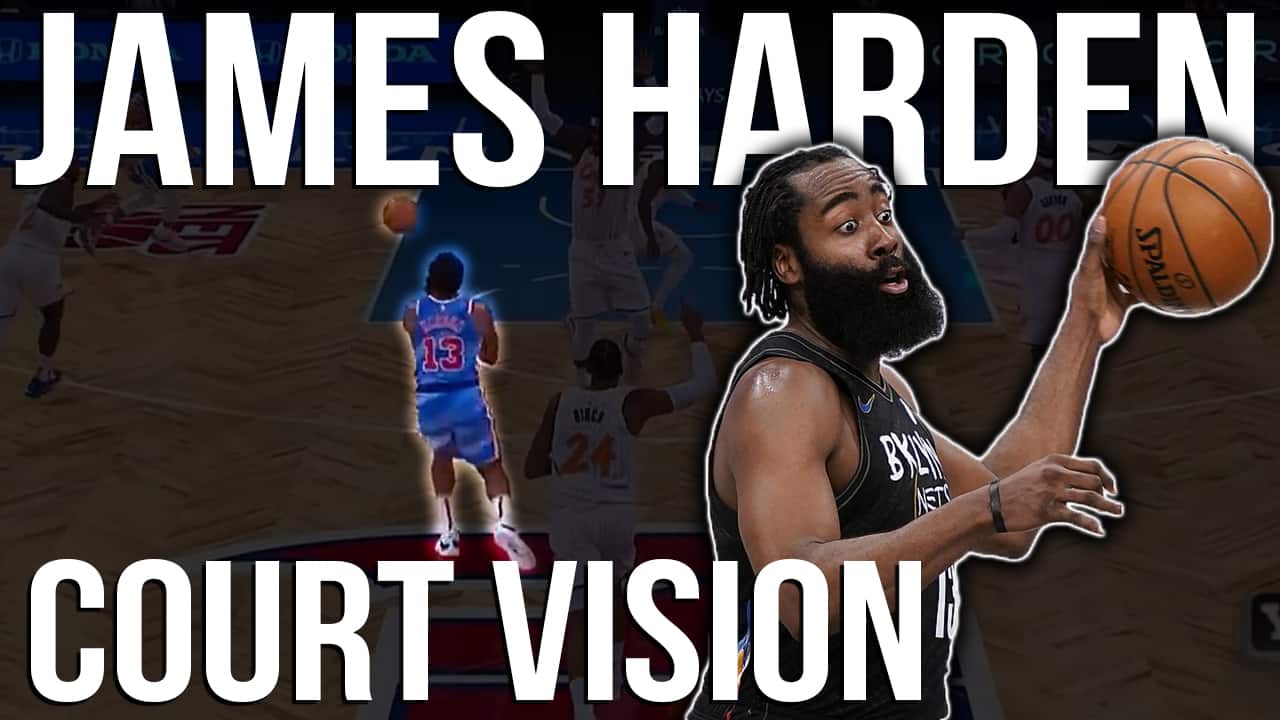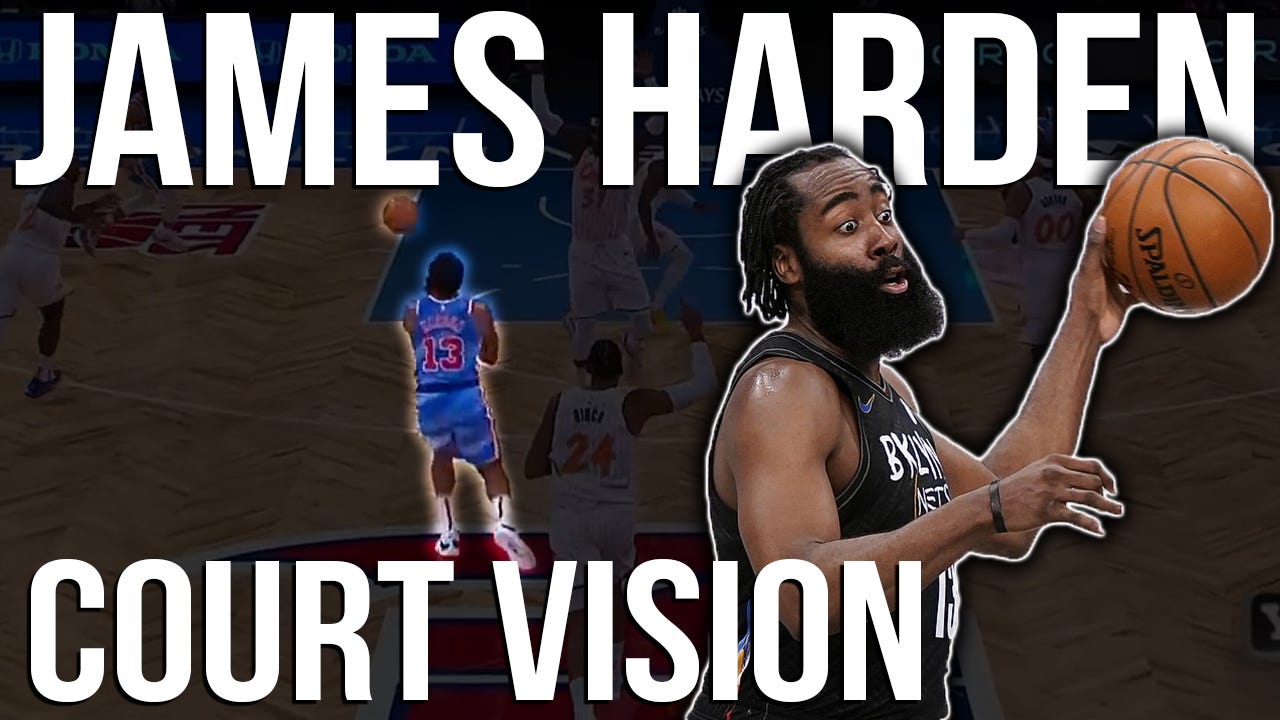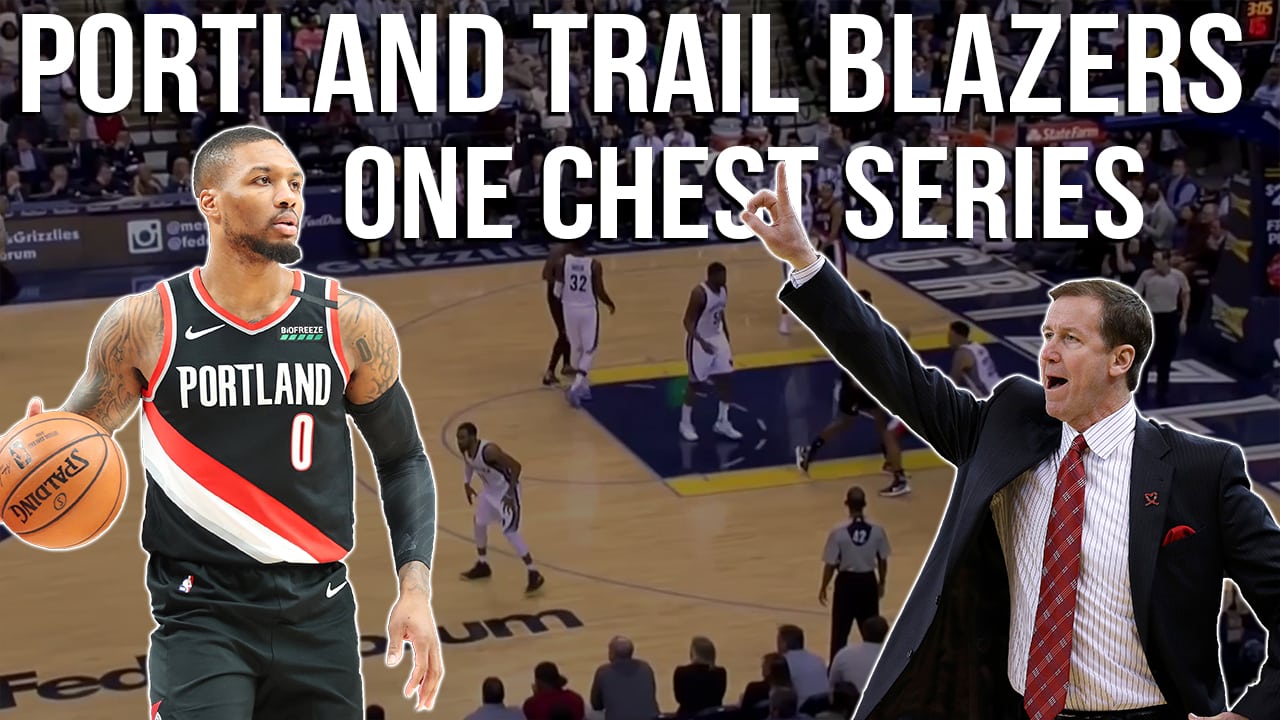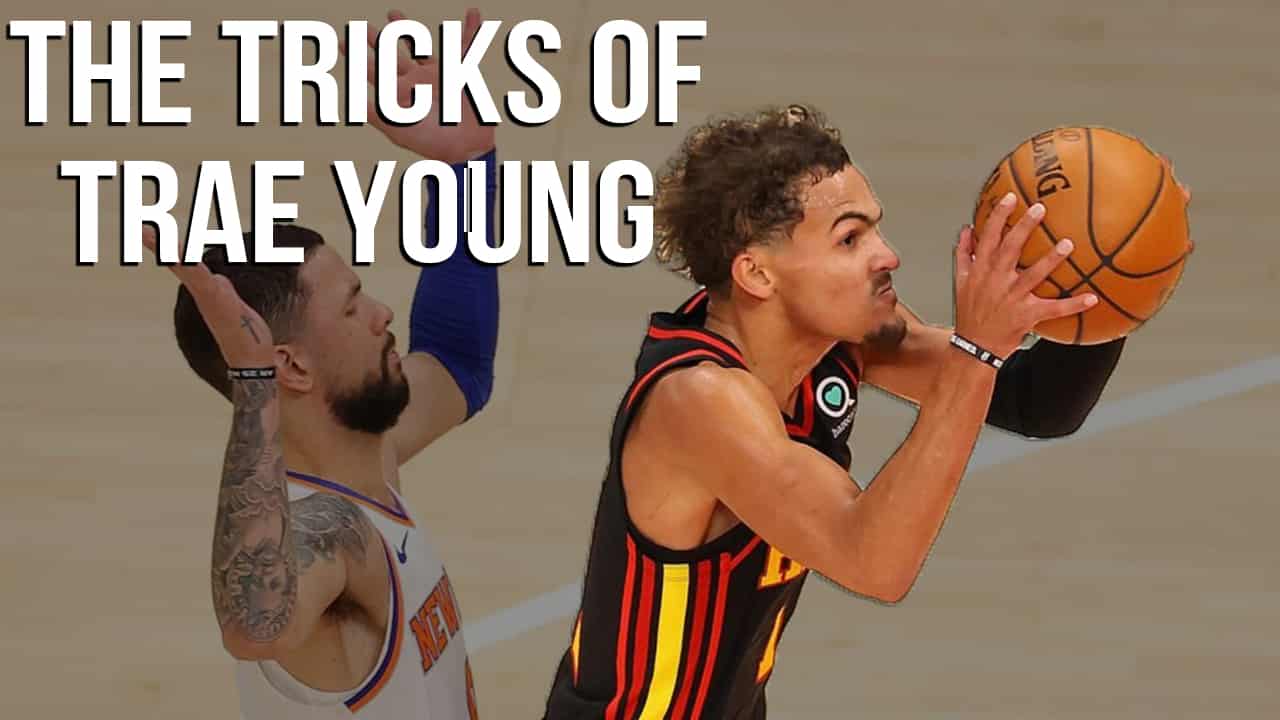James Harden Court Vision
Since his trade to the Brooklyn Nets James Harden has averaged 11.4 Assists per game, leading the NBA by a wide margin over the rest of the pack. Kyrie Irving told Harden that he is the point guard, and it is clear why. Harden’s court vision has always been elite, but with the talent on this Nets roster – even without Durant in the lineups – his ability to create has been nothing short of mesmerizing.
Overall assists don’t necessarily don’t tell the entire story, so using assist percentage gives us a clearer estimated impact players make when on the court. James Harden’s current season assist percentage is at 46%, or when he is on the court he assists on almost half of his teammate’s made shots, this has dropped slightly with Brooklyn overall to 42.6%, partially because he is flanked by legendary shot makers Kyrie & Durant. According to cleaning the glass’ data this leads the league, although he does not always focus on creating for others since he is such a gifted scorer and his prowess in isolation – Harden is currently in the 80th percentile in assist per usage at 1.33 – he still leads the league in assists and assists percentage.
Previous Court Visions & Passing Edits:
James Harden Court Vision Playlist
James Harden Pick & Roll Passing Edit (17-18)
It’s no surprise that Harden is leading the league in Assists again, his best overall assist season up to this year was the first year Mike D’Antoni took over the Rockets in 2016-17 – with a traditional style ball screen attack of course. Although the Rockets morphed into ISO-Ball with Harden controlling everything in historic 1 on 1 isolation scoring seasons, D’Antoni’s impact was clear, he had a similar boost to Steve Nash once he joined Phoenix who jumped from a 36% assist percentage to a 46% assist percentage. It’s no surprise then that with Nash as the head coach and D’Antoni as an assistant, the ball screen attack and style of play combined with the personnel the Nets have – has allowed Harden to flourish again as a playmaker.
Backdoors
Off the ball, teams will likely try and deny players like Kyrie, KD & Joe Harris – especially when the Nets go to the off-ball screening actions for those players. Anytime off the ball the player denying loses sight of the ball, Harden will loft it over the top for an easy score just like in this example to KD.
Of course, this is nothing new if you have watched KD play before, he and Russ had a ridiculous connection on these passes back in 2016.
Backdoor – Rollers
These are unlike traditional backdoor cuts, where the defense overplays and then the offense can go backdoor, these are from ball screens. Since Harden commands so much attention in the ball screen with his scoring ability, the defender guarding will lose contact and sight of his man, allowing him to sneak behind the defense. In this example, we can see a double ball screen with Kyrie and Green, and expecting Kyrie to pick and pop after the switch – Powell looks to the wing only to realize Kyrie is scoring a layup behind him already.
In this scenario, Green sets a ball screen for Harden and the Warriors are going to switch with Draymond and Wiggins. This normally wouldn’t be a problem since Green is not a post-up threat and Draymond can handle his own on the perimeter. But with a small ball lineup on the court spreading the floor, all it takes is for Wiggins to lose vision and remain too attached for Harden to anticipate Green being open backdoor for the layup.
Backdoor – Early
James Harden and Bruce Brown have had an awesome connection – especially over these last 2 weeks. One of the best ways that Brown has connected with Harden is in early offense/transition looks. Brown runs the floor hard, and Harden is finding him cutting backdoor behind defenses when all the attention is on him.
Backdoor – Early Patience
In this scenario, they use Bruce Brown as a Rim Runner, but really he sprints the floor hard and sneaks behind the defense into the lane. Instead of continuing opposite or clearing the lane, he sits behind the defense as Harden pushes the ball. Some players may try to throw the pass early or try and force the pass to Brown who was open for the layup, but Harden shows patience and uses a ball fake to get a better passing angle to get the ball to Brown on target for a layup. Another key to this is to know that players are told and drilled to not help off corners, especially in transition so Harden knew Brown would remain open even after the initial opportunity.
Home Runs
Another backdoor-ish play is to make the defense pay in transition by throwing it over the top of them. I call these plays “Home Run” plays, also Kevin Love was famous for his “Touchdown Passes” to teammates for easy layups. This is perhaps the highest value play Harden can make for his teammates in transition for easy layups.
Pitch Ahead
Harden’s ability to catch and throw it to teammates sprinting up the floor for pitch ahead passes really makes this Nets team dangerous. Even if the Nets get scored on (which, you and I know happens all too often), Harden’s first look is to throw it ahead up the wing for teammates to attack early constantly putting pressure on the defense.
Trailers
As Harden brings the ball up he obviously is looking ahead for passes and opportunities to advance the ball, but when he pushes he creates chaos. Forcing the defense to load up and stop him in transition unleashes the Nets offense, and that leads to finding trailers in transition either on the wing or the sweet spot in the middle of the floor.
Backdoor – Sneak
Whether it is a zone or a man defense, when an offensive player gets behind the defense Harden is great about finding them quickly. Recognizing when the player can sneak behind the defense and be open without the defense recovering is something that James Harden has mastered.
Pro Passes
There might not be a single-player I have watched who has better chemistry when passing to bigs than James Harden. His ability to click with bigs and even players in the dunker’s spot so quickly is something that every player can learn from. The pass he has mastered when help comes is what I have heard multiple college coaches teach as the “Pro Pass” or a lob pass to the corner of the backboard to let the big go up and dunk it.
Dishes
When he is ISO or looks to drive against the defense it is inevitable that help will have to come otherwise it will be too easy of a finish for him. When help does come he is great at showing his eyes and even body to the rim, then dishing the ball off for easy finishes.
Drop Pass
I wasn’t sure what to exactly call this, but I laned on drop pass since Harden shows the ball for a shot then drops it off for easy finishes.
Flash Cuts
One of the biggest advantages on offense that the Nets can create is they have players who draw so much attention, so if you can become a great cutter into space you will get rewarded with easy layups. Whenever Harden attacks or gets downhill the defense will load up and try and slow him down so the ability to find players when they flash into space
Flip Pitch
A rare pass that Harden can and will make is the Flip Pitch pass to a player for a quick shot. Essentially it looks like a flip pass to a player, but Harden flips it higher so the player can catch it in their shooting pocket. By flipping it higher it has the same impact as a flip would, but the shot is a little easier since it feels like a pass.
Kick – Catch Behind Pins
When you watch the Nets you are going to see a ton of guard/guard ball screen action involving Harden and players like Harris, Brown, and Kyrie. Once this is ran, the defense has the choice to switch it, hedge it and the off-ball players can either stay attached or load up and sag off the ball. Since most of this off-ball action is not threatening to score the off-ball defenders will sag off and usually switch this action to remain in defensive position. After seeing this for years and in the playoffs Harden can recognize this, then throw it behind the switch and catch the defense off guard for open 3’‘s.
Kick – Flare The Help
Another example of punishing help defense is after the guard/guard ball screen to flare the help. When the attention is on Harden he still has the ability to peek and see if anything develops off the ball.
Pocket Pass
If teams play regular pick and roll coverage (no switching) like most teams do in the regular season, James Harden will pick them apart repeatedly. His go-to move when passing to the roll man is a simple left-hand pocket pass that he has mastered the timing and precision of.
Kick – Low Tag
The most common way NBA teams defend the ball screen is by tagging with the “Low” man or the man defending the opposite corner. He is responsible for holding and taking away the roll man opportunity, then recovering out to his man in the corner. The problem: Harden gets downhill too fast and reads the game too quickly. His ability to turn the corner in either ball screen or hand-off situations (essentially same reads as ball screens) puts so much pressure on the defense that he kills teams’ defensive schemes.
Kick – Nail Tag
Some teams, let’s use the Magic as an example, will choose to tag or load up with both the players opposite in the lane. If the nail defender chooses to tag too far or get sucked in it becomes an easy left-hand hook pass for Harden to find an open shooter.
Kick – Shake Read
The previous two examples were looking at coming off toward the “2-Side” of the ball screen, now let’s look at the single side of the ball screen. This read becomes simple if the player defending the corner helps it is a kick, if he stays at home it is a pass to the roll man.
Kick – Corner Sags
Sometimes teams help or sag off the corner. While definitely not conventional or recommended, if they do Harden just passes to the corner for easy 3’s.
Kick – vs Nail Load
Some teams choose to help in the gap or at the nail to stop drives, Harden will usually attack this help to draw the defense in and then kick to the opposite slot for easy shots.
Kick – vs Sag
In ISO situations teams will usually sag off their man to load up on driving lanes or make it seem like there is nowhere for Harden to go. Harden has been so clever and deceptive this year by faking step backs, drives, and lulling the defense to sleep to kick to open 3 point shooters.
Pick & Pop Variations
Harden has been operating with pick and pop threats in the ball screen for the past 5 years now, starting with Ryan Anderson and now evolving to the guards at Brooklyn and Jeff Green as a small-ball 5. He is so crafty at keeping 2 on the ball with subtle movements like he is going to drive, then finds the pick and pop for an easier look from 3.
Pins
One of the most important things that Harden does with his court vision is his passing to shooters off of screens. We will see the Nets run lots of variations of off-ball actions for their shooters, and Harden’s ability to make a pass “on time and on target” to shooters in rhythm for cleaner looks.
Flash vs Trap
We haven’t seen traps against Harden too often yet and it will be harder this year but if he is the lone star on the court or if teams are trying to avoid the mismatch they will trap him. When they trap him the Nets essentially have two looks – either short roll or flash. The flash is essentially a roll but the player who would be looking to roll or clear space for ISO stays in a pocket of space to be available for a pass.
Short Roll vs Trap
Of course the most common look is to short roll, or stay available on the pass from Harden and then play 4 on 3.
I am really enjoying this Nets team with Harden running the show, and cannot wait to dive into more film as the playoffs grow closer.
Thanks,
Coach Pyper




